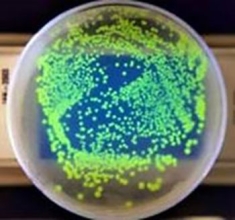11:115:110: Experiments With GFP
Rutgers Summer Session Course (3 Credits) for students interested in exploring STEAM fields and First-Year College Students
We are excited to offer the summer course “Experiments with GFP” for high school students eager to explore the world of STEM education in a college setting. This practical course introduces students to fundamental biochemical techniques, provides access to common laboratory equipment, and includes guidance from experienced professionals while exploring recombinant protein technology. We create an interactive and supportive environment that promotes meaningful engagement with instructors and provides hands-on learning experiences in a small group setting with 14 students. Students who complete the course receive college credits, which are transferrable to almost any other college or university.
Where and When
This hands-on biochemistry lab/discussion course is held in a Rutgers biochemistry teaching laboratory on the second floor of Lipman Hall on the Cook Campus of Rutgers University, 76 Lipman Drive, New Brunswick, NJ, 08901.
Schedule of Classes Summer 2025
Course #11:115:110 - EXPERIMENTS WITH GREEN FLUORESCENT PROTEIN (3 credits)
Session Dates: 07/07/20254 - 08/01/2025
| Monday | 8:00 a.m. - 10:45 a.m. | Lipman Hall (LH-207) |
|---|---|---|
| Tuesday | 8:00 a.m. - 10:45 a.m. | Lipman Hall (LH-207) |
| Wednesday | 8:00 a.m. - 10:45 a.m. | Lipman Hall (LH-207) |
| Thursday | 8:00 a.m. - 10:45 a.m. | Lipman Hall (LH-207) |

What Is GFP?
GFP (green fluorescent protein) is a Nobel Prize-winning protein used in almost every area of biotechnology and biomedicine. Its brilliant green fluorescence makes GFP an ideal teaching tool, as every step in a protocol can be followed in real time. Unlike most biochemicals, which cannot be seen, GFP is always visible.
The Science

In a fully equipped university teaching laboratory, we express, purify, and investigate the thermal stability of recombinant GFP produced in E. coli. GFP serves as an essential model for studying various proteins of interest. We grow E. coli cell culture and induce GFP expression. We carry out plasmid DNA purification and restriction analysis. We explore principles of protein purification based on the hydrophobicity of GFP and use salt precipitation and column chromatography. We observe GFP fluorescence throughout the process and monitor GFP purity with UV-Vis spectrophotometry and protein gel electrophoresis. We create science posters to share our results with our peers and discuss the insights we've discovered.
Tuition and Fees
The cost of the program for 2025 is expected to be:
- Approx. $1,737 for NJ Residents
- Approx. $3,948 for Non-Residents
Please note that there are no departmental scholarships available.
How to Apply
Applications will be reviewed on a first-come, first-served basis until the program is filled, so it's advisable to submit your completed application as early as possible. Late applications will only be considered if there are available spots.
Requirements for Program Applicants
- Must be aged 16 or older by the start of the course (July 7, 2025)
- Must be a U.S. Citizen, Non-Citizen Permanent Resident, or Current Visa Holder
- Minimum high school GPA of 3.0 (unweighted).
Compiling Documents to Apply for the Course
Students must create a profile and complete the Summer Scholars Application form.
Here is a checklist of the documents to be uploaded and information needed when filling out your application. Please try to prepare the following beforehand:
- Academic Transcript (updated transcript) to be uploaded to the application
- Signed Parent Permission Form
- Letter of Recommendation speaking on your educational achievements. Obtain a letter of recommendation from your teacher/counselor. If a counselor/teacher prefers to email the letter directly for the application portal, please request them to email at: nk353@sebs.rutgers.edu.
- Information about the course to be filled on the application:
- Course # 11:115:110
- Section# Q1
- Index# 04001
- SPN#: To obtain a Special Permission Number from the Department:
- Please email a copy of your recommendation letter to Nalini Kaul (nk3535@sebs.rutgers.edu) AND
- Please complete the form.
Once again, we extend a warm welcome to you as you join our program. We truly hope this short journey brings you some valuable insights and helps you on your academic adventure!
Registration
Visit the following link for registration information and high school student requirements.
Spread the Word
Back to Courses page